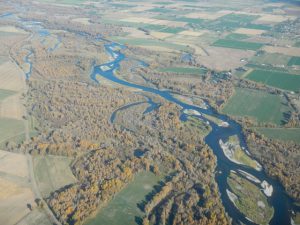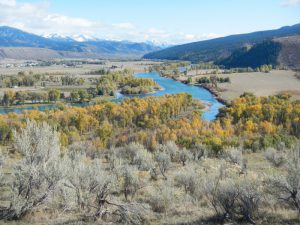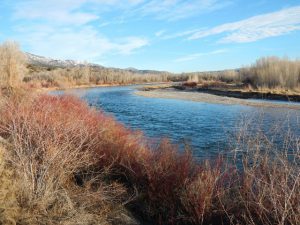South Fork, January 2nd, 2021
It looks like about 900 cfs will be the maintenance flow out of Palisades Dam until the upcoming irrigation season. That seems a bit small to some folks, but consider that tributaries add a considerable amount of water to the river on downstream at least to Heise where the flow increases to around 1300 cfs.
In any case, the South Fork is arguably our most popular river for angling. That being said, IDF&G spends a good deal of its fishing resource allocations on studying and maintaining its salmonid population. Below are results of recent studies that indicate good news for the salmonid population, the wildlife that depends on it, and anglers.
High trout numbers continue in the South Fork Snake River
By Pat Kennedy
The South Fork Snake River (SFSR) in eastern Idaho supports the largest river population of native Yellowstone cutthroat trout in Idaho as well as other popular game fish including Rainbow trout and Brown trout. Idaho anglers have repeatedly asked Fish and Game managers to focus management efforts on protecting native trout species when possible. This public sentiment is reflected in our state fish management plan where the goals for the South Fork Snake River include: protecting the genetic integrity and population viability of cutthroat, and reducing rainbow trout abundance to less than 10% of the trout in the upper river near Conant, as was the case in the mid-1980’s. These goals are also reflected by the Yellowstone cutthroat trout management plan. Each fall, IDFG employees use boat electrofishing techniques to estimate trout numbers in order to gauge management efforts relative to goals stated in the management plan. Results from 2020 surveys suggest two things; trout numbers are at a record high and Rainbow trout still comprise more of the population in the upper South Fork than called for in the management plan.

Almost every year since 1986 IDFG conducted abundance estimates in October near the Conant boat ramp to monitor trout abundance in the upper river. At our Conant monitoring reach, we estimated trout densities to be 6,302 fish/mile. The 10-year average is 4,710. Good trout numbers are expected to contribute to continued good catch rates for anglers. Rainbow trout, which are the biggest threat to cutthroat trout through competition and hybridization, continue to provide management challenges. Rainbow trout made up 43.1% of the trout catch, so IDFG plans to continue efforts to lower their abundance using the angler incentive program and other tactics.

Pat Kennedy, IDF&G
Figure 1. Estimates of fish per mile for Yellowstone cutthroat trout (YCT), rainbow trout (including hybrids; RBT), and Brown Trout (BNT) at the Conant monitoring reach from 1982 through 2020 with 95% confidence intervals.

Abundance surveys have been conducted near the Lorenzo boat ramp most years since 1987 to monitor abundances in the lower river. At Lorenzo, Yellowstone cutthroat were estimated at 1,260 fish/mile, the highest on record (Figure 2)! The ten-year average for cutthroat is 407 fish/mile. The total trout estimate was 2,650 trout/mile which was significantly higher than the ten-year average of 1,889 trout/mile. Brown trout are doing well here too with 1,390 fish/mile which is slightly lower than the ten-year average (1,477 fish/mile).

Figure 2. Estimates of fish per mile for Yellowstone cutthroat trout (YCT) and brown trout (BNT) at the Lorenzo monitoring reach of the South Fork Snake River from 1987 through 2020 with 95% confidence intervals.

Pat Kennedy, IDF&G
The most important take-home message from these surveys is that trout abundance is high in the SFSR. The total trout estimate is higher than ever estimated at Conant, since 1982. Cutthroat appear to be doing fairly well, despite the continued threats from rainbow trout. Unfortunately, what’s good for one species seems to be good for the other, as rainbow trout continue to comprise a greater proportion of the population.
Other rivers in the western U.S. also host estimates of trout per mile in the thousands, but few boast estimates higher than 5,000 trout/mi. Within Idaho, the South Fork Boise, Big Lost, and Henry’s Fork rivers boast some of our highest abundance estimates, but none have exceeded 6,000 fish/mi. Other rivers in the west such as the Green River below Flaming Gorge reports 10,000 trout/mi, but stocked 14,500 RBT in the summer of 2020. Similarly, the Idaho rivers with high abundance typically receive at least some hatchery trout supplementation. The SFSR is not supplemented with hatchery trout. The exceptional wild trout population in the South Fork highlights the extremely high productivity observed in recent years in the river and the potential this tailwater fishery possesses. For anglers, high abundances of trout should ensure that fishing will remain great into next year and beyond.



